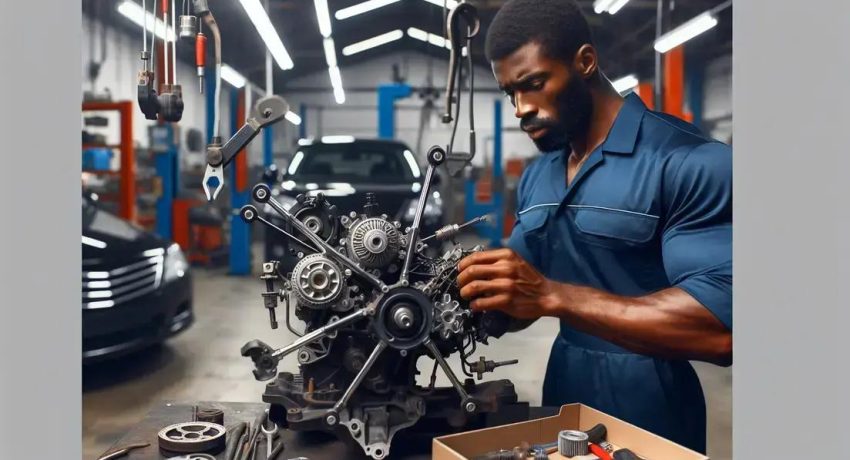To fix power steering noise, check the fluid level, inspect for leaks, listen for pump noises, purge air from the system, and consider professional help if issues persist.
How to fix power steering noise is a question many drivers ponder when faced with this issue. It’s not just annoying; it can indicate underlying problems. Let’s dive into what you can do to solve it.
Table of Contents
ToggleIdentifying the causes of power steering noise

Understanding the causes of power steering noise is vital for effective troubleshooting. Various factors can contribute to this issue, so let’s explore them.
Low Power Steering Fluid
One of the most common reasons for power steering noise is low fluid levels. Check your vehicle’s power steering fluid reservoir regularly. If the fluid level is low, it can cause air to enter the system, leading to noise. Be sure to fill it to the recommended level and use the correct type of fluid.
Worn or Damaged Components
Another source of noise can be worn or damaged steering components, such as the pump or hoses. Listen for whining or grinding noises, which can indicate that the power steering pump is struggling to push fluid through the system. Inspect hoses for leaks or cracks and replace them if necessary.
Contaminated Fluid
If the power steering fluid is dirty or contaminated, it can interfere with the system’s operation. Dirty fluid can lead to reduced performance and increased noise. It’s important to flush the system regularly as part of your vehicle’s maintenance routine.
Air in the System
When air gets into the power steering system, it can create a whistling or bubbling sound. This typically occurs after fluid changes or leaks. To eliminate air from the system, turn the steering wheel from lock to lock several times while the engine is running. This action helps to purge the air pockets.
Alignment Issues
Poor wheel alignment can also cause power steering noise. If your vehicle is misaligned, it can put extra stress on the steering system. Pay attention to steering responsiveness and unusual noises when turning. If you suspect alignment issues, take your car to a professional for adjustment.
Step-by-step guide to fixing power steering noise

If you’re experiencing power steering noise, don’t worry. Here’s a step-by-step guide to tackle the problem effectively.
Step 1: Inspect the Power Steering Fluid
Start by checking the power steering fluid level. Open the hood and locate the power steering fluid reservoir. If the fluid is low, refill it with the appropriate type of power steering fluid recommended in your owner’s manual.
Step 2: Examine for Leaks
Look for any visible leaks around the power steering pump and hoses. If you see fluid pooling under the vehicle or on components, you may need to replace the faulty hose or seal.
Step 3: Check the Power Steering Pump
Listen carefully to the power steering pump while the engine is running. If you detect whining or grinding noises, the pump might be failing. Inspect it for any signs of wear or damage.
Step 4: Purge Air from the System
If you’ve recently changed the fluid, air may have entered the system. To remove air, turn the steering wheel from lock to lock several times with the engine running. This helps the fluid circulate and eliminates air bubbles.
Step 5: Replace Contaminated Fluid
Dirty or contaminated fluid can cause unwanted noise. If the fluid appears dark or has debris, it’s advisable to flush the system. Drain the old fluid and replace it with fresh fluid.
Step 6: Tighten Loose Hardware
Check that all hardware, such as bolts and brackets, is securely fastened. Loose components can produce noise and affect steering performance. Tighten any loose parts as needed.
Step 7: Seek Professional Help
If the noise persists after performing these steps, it may be time to consult a professional mechanic. Ongoing issues could indicate more serious problems that require expert diagnosis.
Addressing power steering noise is essential for smooth driving
In conclusion, knowing how to fix power steering noise empowers you to maintain your vehicle’s performance. By following the steps outlined, such as checking fluid levels and inspecting for leaks, you can often resolve the issue on your own.
If problems continue, seeking professional help is a wise choice. Keeping your power steering system in top shape ensures safer driving and enhances the overall driving experience.
Don’t ignore the sounds your car makes; addressing them promptly can save you time and money down the road.
FAQ – Frequently Asked Questions about Fixing Power Steering Noise
What are common causes of power steering noise?
Common causes include low power steering fluid, worn components, contaminated fluid, air in the system, and alignment issues.
How can I check my power steering fluid level?
Open the hood and locate the power steering fluid reservoir. Check the dipstick or markings on the side to see if the fluid is at the recommended level.
What should I do if I hear whining noises from the power steering?
Whining noises often indicate low fluid or a failing pump. Check the fluid level first, and if it’s adequate, consider having the pump inspected.
Is it safe to drive with a noisy power steering system?
It’s best to have the issue checked as soon as possible. Continuing to drive with power steering noise may lead to further damage or failure of the system.
How can I purge air from the power steering system?
Turn the steering wheel from lock to lock while the engine is running. This motion helps to eliminate air pockets from the system.
When should I seek professional help for power steering issues?
If you’ve checked the fluid, tightened components, and the noise persists, it’s best to consult a mechanic for a thorough inspection and diagnosis.






